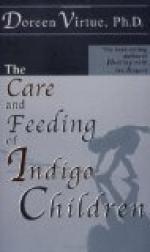What would be a proper schedule for an average child during the third year?
7.30 A.M. Cereal: cooked (preferably over
night) for three
hours,
although a somewhat larger variety may
be
given than during the second year; given as
before
with milk or thin cream, salt, but very
little
sugar.
Warm
milk, one glass.
A
soft egg, poached, boiled or coddled.
Bread,
very stale or dry, one slice, with butter.
10 A.M. Warm milk, one cup,
with a cracker or piece of very
stale bread and butter.
2 P.M. Soup, four ounces;
or, beef juice, two ounces.
Meat: chop, steak, roast beef or lamb
or chicken.
A baked white potato;
or, boiled rice.
Green vegetable: asparagus tips, string
beans, peas,
spinach; all to be cooked until very
soft, and
mashed, or preferably put through a
sieve; at
first, one or two teaspoonfuls.
Dessert: cooked fruit—baked
or stewed apple, stewed
prunes.
Water; no milk.
6 P.M. Cereal: farina,
cream of wheat, or arrowroot, cooked
for at least one half hour, with plenty
of salt,
but without sugar;
or, milk toast;
or, bread and milk;
or, stale or dry bread and butter and
a glass of milk.
PART III
THE DIET OF OLDER CHILDREN (FOURTH TO TENTH YEAR)
Throughout this period the largest meal should always be in the middle of the day, and a light supper given, very much like that described for the third year. During the first half of this period, milk may be allowed once either between breakfast and dinner or dinner and supper; no other eating between meals should be permitted, but water should be allowed freely.
MILK AND CREAM
What part of the diet should milk form during childhood?
It should form a very important part up to the tenth year; nothing can take its place. There are comparatively few children who cannot take and digest milk if it is properly fed.
Why is milk so advantageous?
Because no food that we possess has so high a nutritive value as milk, for the amount of work required of the organs of digestion. It is, therefore, peculiarly adapted to the diet of the child.
What are the essential points in the use of milk?
It should be clean and fresh, but not too rich. It is a mistake to select for any children the rich milk of a Jersey herd and use it as though it were an ordinary milk. For children who have difficulty in digesting milk, it should be somewhat diluted, i.e., one part of water to four parts of milk, or salt or bicarbonate of soda should be added. It is also important not to give milk at meals when fruits, especially sour fruits, are allowed.




